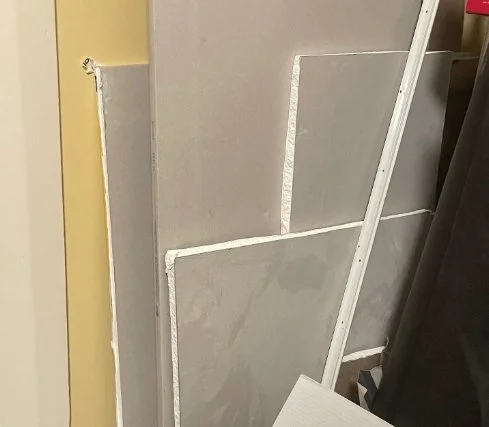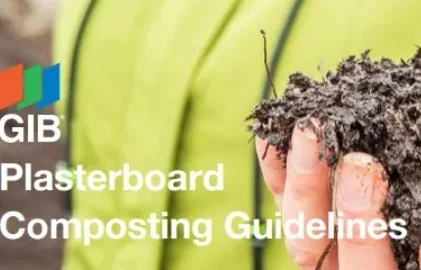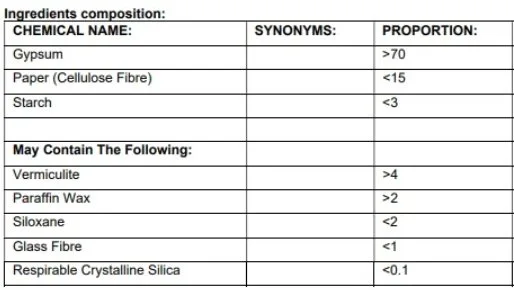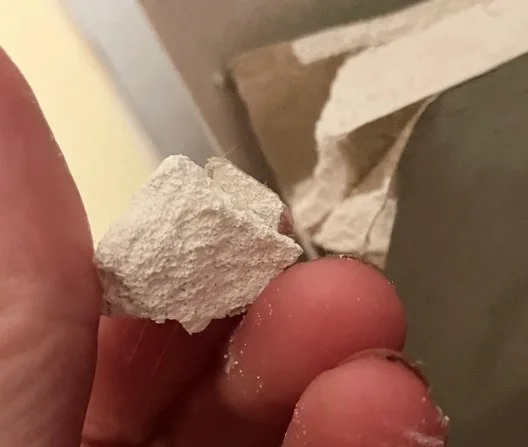What the heck is in GIB? What the heck is gypsum?
Hello everyone! This would usually be a paid blog post, but I am furious with my chickens for destroying my vege garden, and my paid blog posts for the next little while are about soil health. So in lieu of a post telling you that it is still Spring, have one about my current deep dive into the world of gypsum, and how to scam free soil amendments.
So, GIB. We are going to have to start at the start here…
GIB is a brand name for plasterboard. This is what the walls are made from on a huge number of houses. If you live in NZ or Australia, and you can’t see wood grain on your walls (if they are painted or wallpapered), and if they aren’t super old, then you have plasterboard walls.
I am going to keep calling it GIB, that’s what we tend to call it in NZ, although it is technically a brand name and more specifically plasterboard. I would like to note that if your plasterboard is not GIB, it may have slightly different composition, in which case reach out to your primary local brand and ask them for the rundown on the composition of their plasterboard, just to find out the little extra additives in case they are different.
Behold, my pile of hoarded GIB offcuts (we are renovating)
What is plasterboard?
Well, it is gypsum, the thing that every clay garden wants to add to their soil.
It is over 70% gypsum, sandwiched between 2 sheets of thick paper, and sometimes has some additives in it.
It is thrown out in huge amounts by the building industry, because… offcuts. And in renovations, you almost always replace the GIB. it comes in huge sheets and it is not practical to stick lots of little sheets together to make one wall, much to my disdain. So GIB is thrown out a lot.
What is Gypsum?
But GIB is mostly gypsum- the thing that we want to use to remediate our soils. It doesn’t alter soil pH- it isn’t lime. Gypsum is calcium sulfate. It slow releases calcium and sulfur into the soil, both vital for plant growth.
Most importantly, for those who live near the beach, or are dealing with the effects of salt spray… say, for instance, people who live in Wellington… gypsum displaces salt in the soil, and enables it to wash away. Salt will literally bind to soil particles, and not wash away after storms. Gypsum will wedge in and bind to the soil in the place of salt, leaving the salt to wash away.
Gypsum will also generally help to prevent runoff of nutrients generally (by improving soil structure) and improve nutrient uptake by plants (by making sure nutrients are sitting in the right place in the soil).
I couldn’t say it better than Live to Plant, so here is a direct quote for those interested in the science regarding salt and gypsum-
Cation Exchange Process
Soil particles have negatively charged sites that attract positively charged ions called cations. In sodic soils, these sites are saturated with large amounts of Na⁺. Sodium causes particle dispersion because its single positive charge and large hydrated radius create weak bonds with particles.
When gypsum is applied:
Gypsum dissolves into Ca²⁺ and SO₄²⁻ ions in the soil solution.
The Ca²⁺ ions have a double positive charge compared to Na⁺’s single positive charge, giving them stronger attraction to negative sites on clay particles.
Ca²⁺ displaces Na⁺ from exchange sites.
The freed Na⁺ ions remain dissolved in the soil solution.
Sulfate ions help promote the downward movement of Na⁺ beyond the root zone during irrigation or rainfall.
With Na⁺ removed from exchange sites, clay particles flocculate (bind together), improving soil structure.
So to be clear, gypsum
Does not alter the pH of soil
Releases desireable nutrients in an effective way
Slow releases calcium and sulfur, calcium being an extremely important nutrient in soil
Improves soil structure and reduces runoff
All around A++ thing to add to soil
When should you NOT add gypsum to soil?
If you have sandy or loamy soil which is not by the beach (because gypsum will
If you can easily dig a hole because the ground is light and friable
All the same, it is unlikely to hurt it.
So, you can see that I have been trying to work out whether I can use GIB on the garden for a while. Gypsum is great, but I live in Clay City like most New Zealanders, and you have to just keep adding and adding it in order to get nice, friable soil.
You can use GIB on the garden… I think
I finally got around to hassling GIB to see what they could tell me. They sent me their info sheet on composting GIB, but it didn’t tell me much except that we should do so.
Then after some further prodding I was sent their info sheet on everything which is used in GIB- you can find it here
Everything which is in GIB
You can’t use GIB if it has paint on it, if it is ‘special’ like designed for wet areas, etc. But plain old plasterboard, even mouldy old plasterboard, appears to be fine. Paper is fine, as is starch. Vermiculite is a naturally occurring mineral. Glass fibre, shrug. Crystalline Silica, not a problem.
Paraffin wax is derived from petrol, which isn’t great at the manufacturing end and is not good for soil. I have looked and looked about how it breaks down, but aside from finding that paraffin wax requires heat to degrade (instead of being paraffin wax in your soil forever).. I can’t find a thing. This was somewhat helpful.
Siloxane- silicone and oxygen- this is difficult. It can be broken down in the soil, back into silicone and oxygen- two very helpful things to have in soil. But most of the organisms which break siloxane down appear to be some version of slime mould (which is not in soil), there are some bacteria and one is the thing which makes milk spoil (P. fluorescens) so that indicates that it is probably quite a common bacteria. I am not too worried about siloxane in soil (although manufacturing it is really bad for the planet). Interesting paper about siloxanes
I would say that, assuming there is no residue of other chemicals on your GIB, it is a great thing to smash up and use in the garden. Please mask up when doing so, as the powder from GIB is going to irritate your lungs something chronic!
Bit of a conclusion
I have spent a lot of time trying to work out how to break plasterboard back up into powder, and I’d love to hear your ideas if you have any. The big problem is that gypsum is SO GOOD at blunting blades. You’d have to have a very specific type of chipper to throw it in.
How great would it be if we could easily break it up and add it to our soil. Diverting GIB from our landfills and into clay or salt laden soil would be such a great thing to do. Cue my new obsession. Let me know what you think about using GIB in the garden and throw some tips at me!
You can probably tell that it isn’t super crumbly, given I snapped this off of the corner…
Some sources I used, mostly about gypsum in soil-
Calculating gypsum requirements for sodium soils
Harnessing the short and long term effects of gypsum
Should you use gypsum for soil?
I also found GIB the company to be extremely helpful! They just sent me the info sheets which are linked throughout this post.



